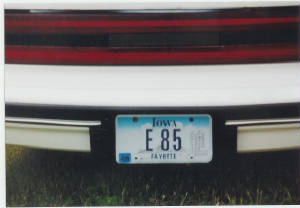 This web site is for everyone who is fed up with the 40% price hike in gasoline these past few months, and especially for
those of you who want to make your own fuel. If you have ever made your own beer or wine, or would like to learn, you can
ferment any starchy or sugary foods or waste products into a mash that you can distill into 190 proof alcohol. If you are
resourceful, you may even find stuff you can use for free. Once fermented, it is not so hard to distill it to 190-proof with
a modern still. The real good news is that you may not have to do any mechanical work or changes to your car or truck. It
may already be factory ready for E85.
In other pages of this website, I talk about how I always used the 160 to 180 proof I made for running 5 of my own cars on
alcohol, and all ran great on it. I never did any conversion work on these cars, like drilling out the carburetor jets. In
those days (25 years ago) I could simply change the air/fuel ratio just by pulling out the manual choke a tad. But I sometimes
had to deal with water at the bottom of my fuel tank when I switched back and forth from ethanol to gasoline, and I frequently
had to replace the fuel filter, because the slightly corrosive nature of the ethanol tended to scour the inside of my fuel
tank. This was a minor inconvenience, though, as fuel line filters were cheap and easy to replace in those days. Nowadays,
I don't think I could even find my fuel filter, buried under miles of hoses, wires, and other mysterious stuff inside my 2002
model turbocharged engine.
Now, pretty much all modern cars have fuel injection instead of carburetors, which are controlled by a computer chip getting
its information about the type of fuel being used from an O2 sensor, so it makes adjustments accordingly. Even though the
chip may not be factory programmed for E-85, it can be replaced with a chip programmed for E85. More on this, later. The real
big change, however, is that over 2 million cars/year in the USA are now factory ready for E85. So, you may already be driving
an E85 car and not know it.
A lot has changed over the past 25 years, from when I first started building stills and promoting ethanol in 1979. Most of
the big distilleries, like Archer Daniels Midlands, are still in business. (ADM first started making fuel ethanol due to a
direct phone call from President Jimmy Carter in 1980, asking them if they would consider converting their beverage alcohol
production, to help him promote a renewable fuel made from American grown corn. It took them less than a week to say, "Yes!".)
They now have many processing plants, each making over 100 million gallons per year of 200-proof ethanol, which they sell
to the fuel industry at an enormous profit.
Gasohol was introduced in 1979 (10% ethanol, 90% gasoline), with quite a bit of confusion among consumers over whether or
not it would work in their cars. Gasohol had its proponents and its detractors initially, but gradually became so commonplace
that the term was dropped. Now, in 2004, over 30% of the gasoline sold in the USA contains ethanol. (But only 2% of the total
amount of gasoline we use is alcohol). It is mostly called, unleaded premium.
The use of ethanol as an octane booster is growing all the time, as 20 states now ban MTBE, and more states will soon follow
suit--due to the fact that this toxic fuel additive is highly carcinogenic, and has caused widespread contamination of ground
water. MTBE will be totally banned in the USA by 2012.
Contrary to popular belief, there are more than 3 grades of gasoline. Exxon, for example, makes over 150 blends, for specific
state and regional markets due to regulations, climate, and seasonal temperature variations. Ethanol may be only 2% of the
fuel, or as high as 15%, depending on the Oxygenate requirements and standards for vapor pressure in the summer months (alcohol
has a lower vapor pressure than gasoline. ETOH (ethanol) also has an O2 molecule, so it partially supplies its own Oxygen
for more efficient engine combustion). Today's cars have sensors to match the timing and fuel injection ratios with what you
fill the tank with. This means that most cars now are somewhat flexible, but their programming may only be in a range of 0
to 15% ethanol, not all the way to 85%.
It is inevitable that an aftermarket in re-programmed E85 chips will emerge due to the increasing use of ethanol throughout
the world (ethanol fuel is now a $5 billion dollar per year market), but I do not know of anyone supplying aftermarket FFV
chips at present. There have been a couple people on my online ethanol fuel discussion at Topica who expressed experience
in this matter.
It was really due to Brazil's major switch to ethanol back in the early 1980s that required Ford, GM, VW and Fiat to start
making cars that would run on 180 proof, wet alcohol.
According to Joao Alvarez Filho, a Volkswagen plant manager in Brazil, "The new Brazilian models can run on just gasoline,
or 100 percent alcohol, or any proportion mix of the two," The company prefers to call this innovation, Total Flex, to reflect
the true range of consumer options. The big difference in FFVs in Brazil as compared with those in the USA is that the Brazilian
cars can also adjust to wet or hydrous alcohol down to about 160 proof, or the slightly more expensive 100% alcohol sold at
the pumps. Alcohol generally sells for about $1.00 less per gallon than gasoline. This gives drivers the flexibility of buying
whatever is cheapest at the pumps.
A similar thing is happening in Sweden, where Ford found last year that the flexible fueled Ford Focus outsells the gasoline
(petrol) models four to one. Sweden also has over 400 buses that run on an ethanol/diesel blend. In November 1997, Sweden
introduced the first blending pump in Europe. You can drive up to one of these many blending pumps throughout the country,
and set the percentage of ethanol you want mixed in with your petrol. They provide a tank with 95 octane petrol with another
tank of pure ethanol, and the pump blends the two per your order. In this manner a flexi-fuel car can be filled with E85,
and a normal car can be filled with any mix from E5 to E25. In the rest of the EU, ethanol now has a low tax advantage, and
ethanol is being introduced in slowly increasing incremental amounts.
New GM models--the Tahoe, Suburban, and the Yukon-- all come standard with Flex Fuel capabilities. These alcohol powered vehicles
are all made in Wisconsin, a fact that the current governor, Jim Doyle, is proud of. They provide flexibility to fuel with
E85, gasoline or any percentage combination of the two.
| In Sweden, fuel pumps mix desired ethanol content |
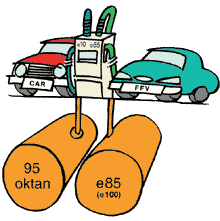
|
| Swedish Flexi-fuel pumps mix gas and ethanol for you! |
| This car has 306,000 miles on it using E85 fuel. |
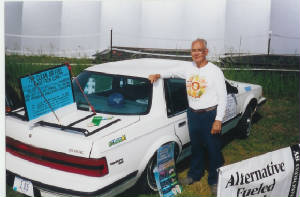
|
| Lowell's 1990 Buick was converted with a computer chip! |
Lowell Langerman converted his 1990 Buick just by changing out the computer chip that controls the fuel injection and timing.
Lowell lives in Iowa, where E85 can be bought at 7 or 8 different pumps throughout the state (Iowa is a big corn-ethanol producer).
In 1990, he got an automotive technician in Phoenix, Az to provide him a computer chip that was programmed to handle E85
fuel instead of E10 (unleaded premium). Most fuel injected cars now have an O2 sensor that detects the oxygen content of the
fuel and varies the injection and timing according, since O2 content can vary from one fill-up to the next. He still has the
original chip if he ever wants to convert back to running straight gasoline (he has to unscrew the glove box lining to get
to this chip, under the dashboard). It only takes him 5 minutes to change the chip if he is driving out of state and can't
buy E85.
Lowell says the E85 burns so clean, even with over 306,000 miles on this car now, he figures he can easily get another
100,000 miles on this engine, no problem! He says the E85 he buys is usually about 30 cents a gallon lower than gasoline.
His only complaint is that the Federal tax incentives for ethanol fuel are supposed to be passed on to the consumer: so really,
the prices should be even lower than they are (the gas retailers, in most cases, keep this money).
|
 |
|
|
 |
|
 |
 |
|
You may be already driving a Flexible Fuel Vehicle and not know it!
| This vehicle comes factory ready for E85! |
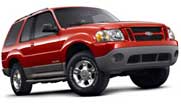
|
| Ford Exporer Sport |
FFVs (Flexible Fuel Vehicles), factory ready to use E-85, are widely available. Approximately 2 million FFVs have already
been sold in the United States, even though many buyers are completely unaware that they use E85 fuel (85% Ethanol). This
is according to the National Ethanol Vehicle Coalition. Check your owner's manual, visit with your dealer, or see this list
of current model year FFVs to determine if you drive a vehicle that can fuel with E85. Here is a list of car models currently
available as flexible fuel vehicles. http://www.eere.energy.gov/cleancities/progs/afdc/search_type.cgi?1|E85_GSLN
This related link takes you to a site where you can search vehicles made in year 2000 or later to see if they are already
considered an FFV vehicle. http://www.eere.energy.gov/cleancities/afdc/afv/models.html
Here is the root link for this site.
http://www.eere.energy.gov/cleancities/
Also you can buy a used FFV that was previously used as a fleet vehicle, at a considerably reduced price. These tend to be
in excellent condition, but may have high mileage.
You can try the General Services Administration (GSA), which leases vehicles to federal government agencies. When these government
AFVs (alternative fuel vehicles, as they are also called) are traded for newer models, GSA Fleet Vehicle Sales auctions them.
GSA resale vehicles are auctioned to the highest bidder at regional GSA events held primarily between April and October. More
auction information on the GSA can be found on its Web site,
http://www.autoauctions.gsa.gov/
| Another factory ready E85 vehicle! |
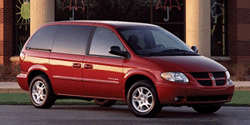
|
| 2002 Dodge Minivan |
| Ethanol price history (USDA) |

|
| This shows you can make money making alcohol! |
Using dry corn to make ethanol
The clear message at this years Fuel Ethanol Workshop in Madison, Wisconsin (June 2004) is that corn is the predominant crop
for ethanol. It is quite economically advantageous: it is 72 to 74% starch, and the spent grain after fermentation and distilling
can be fed wet or dry to cows and other livestock. Corn is quite available without causing a shortage in food supplies, since
the protein content is a valuable end product earning more than the original corn. Even so, the total US corn crop could only
supply about 20% of our gasoline needs, which are massive. However, if we switched to higher mileage models, we could meet
perhaps meet 40% of out fuel needs with corn. The U.S. produced 1.4 billion gallons of ethanol in 1998, and over 3 billion
gallons in 2003, 90% of which is made from corn. U.S. ethanol production has been growing 12 percent each year since 1980.
In Canada, barley is the predominant grain used for ethanol production. While the starch content is only 50% as opposed to
72% for corn, the price is 20% lower, and the resulting DDG has a higher protein content and therefore yields a higher price.
Canada grows more barley and wheat than corn, so it makes sense to use this as a fuel source, just as Brazil uses sugar cane,
since this is a major crop in Brazil.
OK, lets look at the basics of making your own E85 from corn. If you are buying it in 100 lb sacks, you will be paying a rate
probably 2 or 3 times higher than what the big distilleries are paying; size is everything. They pay anywhere from $2.30/bushel
to $3.30/bushel. A bushel is 56 pounds. So this is a variation between $4.10 per 100 pounds (cwt) and $5.89/hundred pounds.
The following analysis is courtesy of USDA, ((2003) when Ethanol was selling for $1.37/gallon and gasoline was about the
same.
Corn to ethanol:
Corn 1 bushel= -$2.11
Ethanol 2.8 gallons= +$3.85
Byproducts,DDGS= +$1.20
CO2(can be sold or used)= + __?_
Value of ethanol & byproducts= +$5.05
Value-added (profit)= +$2.94
Grinding the corn will require some type of grain mill. It needs to be big enough to do the job. Don't try to use a flour
mill unless you can change the grind setting--if you grind it as fine as flour, it will tend to clump up when you add water.
The big corn to ethanol producers recommend a screening mill with a 7/64th inch screen. In other words, a coarse grind, like
corn grits (not flour) is best. Then you need to add water and bring it up to the temperature that is right for the liquefaction
enzyme you need to add. If you dont use enzymes, a lot of the 72% of the starch in the corn will not be converted to sugar.
Yeast eats sugar, not corn.
The big, 40 million gallon per year producers of ethanol normally buy their enzymes by the tanker load. The one company which
will sell a smaller volume is Novozyzme, but the minimum amount is still 264 gallons. On their website, www.novozyme.com
they say, "While other enzymes are delivered in bulk in tankers, Liquozyme SC DS can now be delivered about once a month in
a handy tote (Schütz container) containing 1,000 litres (264 gallons). This particular enzyme no longer therefore needs to
be transferred into a storage tank." But I would write to them anyway, and see if you can get them to supply you a 5 gallon
bucket for "research purposes".
My web page on Mashing and Fermentation provides a good overview of fermentation. Click here.
Drying the alcohol and blending it with gasoline
Mashing and fermentation is covered in other areas of this web site, and how to run the still is covered in the 40 pages of
instructions I send out with the Charles 803 still blueprints. So, the thing you need to know next for making E85 is that
you will need to remove the last 5 or 10% of water by a process called a molecular sieve. I know this sounds technical, but
it is pretty simple, and cheap, too. A sieve is a strainer. The finer the screen, the finer the final product will be, as
when you are sifting flower to remove any clumps or large particles. You can buy Zeolyle, which is a granulated product that
will absorb water but not the slightly larger ethanol molecules. You need to specify that you want to buy the 3 A size (3
angstrom), as this is what you need for making 200 proof ethanol. Buy Type 3A in 10lb bags (looks like a small pea gravel)
it is only a couple of bucks and it works very well to dehydrate the ethanol. We mix about 5 lbs in a 5 gallon can and let
it sit with the ethanol overnight and pour the dehydrated ethanol through a screen, into another can the next day. To get
the water out of the zeolite we just broil it on the backyard grill - it is reusable indefinitely. Or, you can dry it in the
sun by spreading it on a tarp in the summer months.
http://www.thomasregister.com/olc/adcoa/molecula.htm
Finally, you measure that you do really have 200 proof with a hydrometer. If you still have some water in your alcohol, it
will separate out and settle to the bottom when you mix it with gasoline. Also, you should strain your 200 proof through a
fine screen just to make sure you don’t have any zeolite particles that will clog up your fuel filter.
Because of ATF regulations, you will need to add a little bit of gasoline to denature any alcohol you have sitting around.
Just 2 to 5% is enough to do the trick. This way, if you ever do get a surprise visit from the ATF (since they know about
your still because of the Fuel distillation permit you took out), they can see right away that you are making fuel, not drinking
alcohol.
Now, as for adding the gasoline to the ethanol to make E85, even if the car you are driving is listed an this website as an
E85 flexible fuel vehicle, be sure to check your owners’ manual or with your dealer to make sure you got the model with
the right computer chip that will handle E85. I suggest you just wait until you have exactly one half a tank of gasoline in
your car, then fill up the rest of the way with the denatured 200 proof you made. This is because it may take a full tank
of fuel for the car’s computer to fully adjust to the new fuel mix. In the summer you can measure and blend your fuel
so you have exactly 85% ethanol and 15% gasoline, but in the winter, I suggest that you do not run greater than 50% ethanol
so that you don’t have any problems starting your engine on cold mornings.
That’s it. You are on you way to fuel independence. You should make up a bumper sticker or better, a decal which then
identifies your car or truck as an alcohol powered vehicle so you get to drive it in the commuter express lanes. (You can
find a link about commuter lane laws in different states on my FAQ page.)
This link takes you to a site where you can order 3A Zeolyte for dehydrating the ethanol you make to turn it into 200 proof
alcohol, suitable for mixing with gasoline to make your own E85.
You can order the blueprints for building the high proof, high production alcohol fuel still shown on this website. Robert
Warren has perfected this still over a 25 year period and written 40 pages of clear and detailed instructions. You will also
get step-by-step photos not included in this website.

|
| US Ethanol Production in millions gallons per year (USDA) |
Contact us to order the blueprints and instructions for building your own still. You can make your own E85.
|
 |
|
|
|



